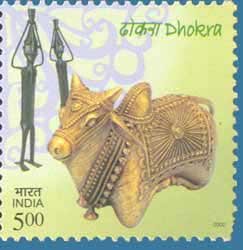Dhokra Ornaments (Metal Casting)

Technical Data
| Stamp Set | Handicrafts of India |
|---|---|
| Date of Issue | November 15, 2002 |
| Denomination | Rs. 5 |
| Quantity | 3,000,000 |
| Perforation | comb 13¼ x 13 |
| Printer | Calcutta Security Printers Ltd |
| Watermark | No Watermark |
| Colors | Multicolor |
| Catalog Codes |
Michel IN 1934 Stamp Number IN 1983d Yvert et Tellier IN 1699 Stanley Gibbons IN 2101 WADP Numbering System - WNS IN045.02 |
| Themes | Crafts |
Table of Contents
Dhokra Ornaments (Metal Casting)
Overview:
Dhokra is a traditional method of metal casting that produces intricate and distinctive ornaments. Originating from the tribal communities of India, particularly in West Bengal, Madhya Pradesh, and Odisha, Dhokra art is renowned for its unique style and craftsmanship.
Craft Characteristics:
- Materials: Dhokra ornaments are made from brass, an alloy of copper and zinc. The metal is often recycled from various sources, giving it a distinct, antique appearance.
- Techniques: The Dhokra casting process involves the lost-wax method. Here’s a basic outline of the process:
- Modeling: An original model of the ornament is created using wax.
- Molding: The wax model is covered with a layer of clay, which is then heated to harden and remove the wax.
- Casting: Molten metal is poured into the hollow mold created after the wax is removed. Once cooled, the clay mold is broken to reveal the metal ornament.
- Finishing: The metal piece is cleaned and polished to enhance its appearance.
Designs and Patterns:
- Motifs: Dhokra ornaments often feature intricate designs, including geometric patterns, natural motifs like animals and birds, and tribal symbols. The patterns are typically created using repoussé (a technique where the metal is shaped by hammering from the reverse side).
- Variety: Common Dhokra ornaments include earrings, necklaces, bracelets, rings, and decorative items like wall hangings and figurines.
Economic and Social Impact:
- Craftsmanship: Dhokra casting is a traditional skill passed down through generations within tribal communities. The process requires considerable skill and artistry.
- Employment: The craft provides livelihoods to many artisans and supports local economies by creating a market for these unique items.
Cultural Significance:
- Heritage: Dhokra art is an integral part of the cultural heritage of the tribes in central and eastern India. It reflects their traditional lifestyle and beliefs.
- Artistry: The method and motifs used in Dhokra casting are deeply rooted in tribal traditions, making each piece a representation of the community’s artistic and cultural identity.
Conservation Efforts:
- Recognition: Dhokra art has gained recognition for its craftsmanship and cultural value, and various initiatives aim to preserve and promote this traditional craft.
- Support: Organizations and government programs are working to support Dhokra artisans by providing training, market access, and resources.
The Department of Posts’ commemorative stamp featuring Dhokra ornaments highlights the exquisite craftsmanship and cultural significance of this traditional metal casting art form. It celebrates the unique artistry and enduring heritage of Dhokra casting in India.
